Common barberry: description and varieties, planting and care

A person always tries to surround himself with vegetation that is of aesthetic and medicinal value. In the case of barberry, both of these indicators are the same. To grow this crop in the garden, you need to know how it looks like, what varieties exist, and what each of them is intended for. The chosen option should take root on the site, for this it is necessary to select a specific place, plant the plant correctly, providing it with subsequent care, otherwise it will not be possible to achieve the desired result.



Peculiarities
Common barberry, or Berberis vulgaris, is a shrub that can be planted by gardeners for various purposes. This plant is attractive in appearance and also benefits from medicinal properties. The description of the culture boils down to the fact that it is an ornamental shrub, the shoots and trunk of which are covered with thorns, which makes it a good option for hedges. The diameter of the crown, which has a spherical shape, ranges from 2 to 2.5 m. The leaves grow alternately and have an elliptical shape.



The shrub looks beautiful in the spring, summer and fall seasons. In the summer, it looks like a green ball, and in the spring it pleases the eye with flowering that occurs throughout the plant. The flowers are yellow and small in size, but a lot of them are formed on the bush. In addition to its pleasant appearance, during flowering, the culture exudes a delicate sweet aroma, which attracts bees, collecting pollen from barberry for very tasty honey.
Flowering lasts almost a month, after which the flowers fall off, and berries begin to form in their place.
In autumn, the foliage changes color from green to a bright red or burgundy hue, which looks very impressive. By September and October, the process of forming berries, which have an elongated shape and a bright red hue, is completed. These fruits are edible and healthy, they can be used for various purposes. They taste tart-sour, but when used correctly, add the desired flavor, color and aroma to the dish. It is important to know that unripe berries should never be eaten - they contain a large concentration of alkaloids that are poisonous to humans.


Varietal variety
Common barberry is found more often than other varieties. You can find it in the southern regions of Russia. In nature, it grows in the forest at the edges, in the forest-steppe, on the hills, as well as in the Caucasus. This variety can reach 3 meters in height, has a spreading shape and thorns on the trunk and branches. This is a green bush, the foliage on which turns red in the fall. Flowering is due to yellow flowers, from which later red elongated fruits grow. Due to the popularity of this plant, there is a wide variety of varieties.
- Variety purple "Atropurpurea" - a medium-sized variety, the foliage of which is burgundy or purple. The inflorescences are orange in color, and the berries are bright and shiny in appearance.
- "Albo-variegata" - characterized by variegated foliage, which has a green color and white streaks.
- "Aureo-marginata" - shrubs have variegated foliage, edged with bronze edges. Without enough light, the color of the leaves fades, the plant begins to grow up and the decorativeness of the barberry disappears.
- "Serrata" - a purple-leaved variety with a jagged foliage.
- "Sulkata" - barberry bushes, which are distinguished by long, ribbed shoots.
- "Alba" Is a special variety of barberry that produces white berries in autumn, while the Lutea variety produces yellow berries.
- "Asperma" differs from all of the above varieties in the absence of seeds in the fruits.
Each option has its own characteristics that attract summer residents and gardeners. When choosing a plant for your site, you need to study its description well and choose the most suitable option.




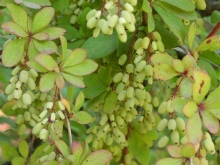
How to plant?
Barberry is planted in autumn or in the last days of spring. For the plant to take root, the seedling must have at least 4 buds on each of the shoots. The planting plan will also be important, which depends on the purpose of the bushes. If a hedge is to be obtained from them, then the distance between the bushes should not exceed half a meter, if the culture is planted in small quantities for decorative or medicinal purposes, then it is better to leave at least a meter between the plants.
In order for the culture to take over well and grow quickly, it is necessary to apply fertilizer to the hole before planting. It is best to use nitrogen-containing dressings, mixtures containing potassium and phosphorus. It is important to choose the right place for the future bush so that it is in the sun all the time, otherwise the color of the foliage will not change, remaining dark all the time.
The soil should be light, not too moist, the bush will tolerate the absence of moisture better than waterlogging.



How to take care of it properly?
Caring for the culture is not particularly difficult, and with the timely implementation of all actions, beautiful and decorative bushes will grow on the site, pleasing the eye with their appearance, flowering, and later fruits. To get a healthy and beautiful bush, you need to perform care activities such as:
- watering;
- weeding;
- loosening;
- hilling;
- pruning;
- top dressing.

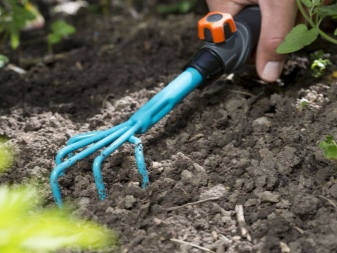


When planning the care of the bushes, you need to know that the culture cannot be waterlogged, therefore it will be enough to water once a week. It is necessary to remove weeds at such intervals that there is nothing superfluous near the plants. Mulching the soil near the trunk helps to protect the young bush from weeds. In order for the bushes to grow well and retain their decorative effect, they need to be fertilized, but for barberry this procedure is enough to do just once at the very beginning of spring.

For a presentable appearance, you need to cut the shrubs, shaping them and removing all unnecessary, the optimal timing for this procedure will be the beginning of spring and the end of autumn. Each gardener can shape the bush at his own discretion, giving it any shape. In order for a crop to grow for a long time, while maintaining its visual appeal and health, it is important to track diseases and microorganisms that may appear on the plant. In addition to taking care in the warm season, it is worth considering activities related to the shelter of barberry for the winter.
Only proper care will allow you to have beautiful and lush bushes that bloom profusely and bestow a large harvest of berries. But without knowing the basics of caring for this culture, it will be difficult to get these results.
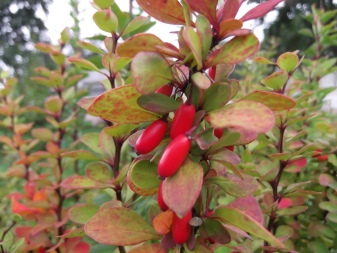

Watering
Barberry is one of those crops that, in a normal state, can completely do without additional watering. This plant does not tolerate waterlogging of the soil very badly, therefore it is recommended to apply moisture only in intense heat, no more than once a week. The peculiarity of the irrigation procedure is that the water must be warm, and it must be poured directly onto the ground near the bush, without irrigating the foliage.
Special conditions should be created only for young seedlings that have just been planted and should take root as soon as possible. In this case, you need to water the barberry within a month, but the frequency remains unchanged, only once a week. In order for the plants to have enough moisture, it is necessary to ensure that weeds do not germinate near them.Moderately moist or slightly dry soil, on which there will be no weeds, will be most favorable for good growth of the shrub.


Top dressing
During planting, fertilizers are applied to the soil, which makes it possible to completely eliminate any additives during the first year of barberry growth. In the second year of crop growth, nitrogenous fertilizers need to be applied, urea is best suited, the concentration of which should be 0.2%. It is recommended to pour at least 10 liters of such additives under each bush. By the end of the season, it is necessary to mulch the soil with peat.
It is recommended to apply urea every 3 years, feeding the soil in which the barberry will grow. If harvesting is also planned from the crop, then additional potash and phosphorus supplements must be added after the bush has stopped blooming, as well as at the beginning of autumn. To quickly cope with the introduction of dressings, it is recommended to use ready-made formulations, for example, "Kemira Universal". In addition, potash fertilizers and superphosphate are also needed, which are taken in an amount of 10-15 g of each substance.
With proper soil feeding, the bush will grow quite large, the color of the leaves and flowers will be bright, and the fruits will be as ripe as possible.


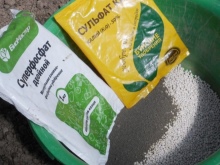
Pruning
The growth of barberry does not differ at a particular speed, increasing by only 30 cm per year, but this does not change the fact that the plant needs a full-fledged pruning. Every season, the gardener or summer resident must carry out sanitary pruning, removing dry, diseased and unnecessary branches. Besides, there is a need for shaping procedures to remove excess growth. Trimming the bushes will depend entirely on the purpose of their growing. For ornamental plants, the formation of a certain external appearance will be sufficient, and to obtain a harvest, you need to cut the bush well, removing excess branches, which will interfere with the full development of fruits.
Another type of pruning is associated with the rejuvenation of the bushes, which is done with prolonged growth of the culture in one place. Branches that have become old and do not give either a decorative effect or fruit should be cut off completely, and in their place new ones should be formed from fresh growth. Pruning is best done in the spring, before the active growth of the buds begins. Shoots should be pruned moderately, leaving a sufficient number of young buds, which will yield a crop this year.


Preparing for winter
Barberry belongs to winter-hardy crops that can withstand frosts down to -40 degrees, so there is no need to take any additional measures to prepare the bushes for the winter season. Young seedlings that were planted this year should be covered in order to protect both roots and shoots from possible frostbite and freezing.
In order for the bush to not suffer in winter, you need to cut it off in time, do not water it from the moment the high temperatures have ended, mulch the soil, check the bushes for pests and diseases and take measures to combat them if found.
If all the measures are carried out, then no cold will threaten the barberry in winter.


Reproduction methods
If there is a need to increase the number of barberry bushes on the site, then you can do it yourself. Like any crop, this plant reproduces in several ways:
- dividing the bush;
- cuttings;
- using layering;
- thanks to the offspring;
- from seeds.
Each of the options can be tried, counting on a positive result, but cuttings and layers are considered the most effective for obtaining a new plant. The use of seeds can lead to the production of any kind of barberry, therefore this option is used less often.


It is possible to get a new bush with the help of offspring only on adult plants with a well-developed root system.Subsequently, new shoots begin to break through from it, which must be separated from the mother bush and planted separately.
If you use the option of dividing the bush, then you need to dig up an adult bush and divide it into 3 parts. Young roots can be cut with pruning shears, while old ones require a saw. It is important to treat the sections with ash, and you can also ceiling the activated carbon and sprinkle it on top. Propagating barberry by cuttings, you can harvest both green and lignified planting material, but in the second, the survival rate is considered significantly higher.


Breeding a new plant using layering is not difficult even for a beginner. To do this, you need to select a healthy long growth and lay it in a pre-made trench, bringing the edge to the surface. Over the summer, this layer will take root and can later be separated from the mother bush as an independent seedling.
Each option makes it possible to get a new plant, so the choice can be made in any direction.

Diseases and pests
Despite the easy care of barberry, problems with diseases and pests will appear regularly. The most dangerous for the culture are fungal infections such as powdery mildew and rust. To treat these ailments, you need to use Bordeaux liquid and a solution of colloidal sulfur. It is necessary to process barberry from the moment the leaves appear, and after that another 3 weeks. If powdery mildew is affected, fungicidal solutions can be used, and to prevent the spread of infection, all affected leaves must be removed and burned.
If we talk about pests, the barberry aphid is especially dangerous for the barberry, which spoils the appearance of the culture. You can fight it with a solution of laundry soap or other folk remedies.
A good effect is observed from the use of insecticidal preparations.



Use in landscape design
Barberry is a beautiful plant with high decorative qualities, therefore it is often used in landscape design. Due to the variety of varieties, a large number of variants of this culture, differing in size, shape, color of foliage and flowers, it is possible to create amazing compositions that will become a real decoration of the territory.
Barberry in landscape design can be used for:
- creating hedges separating certain areas from each other;
- highlighting tracks using a low-growing variety of barberry;
- creating a composition on a flower bed, when forming mixborders, rockeries, rock gardens, rose gardens;
- beautiful combination with autumn colors;
- planting in front of tall plants or conifers.
High levels of decorativeness and ease of maintenance allow the use of barberry for a wide variety of purposes and tasks of landscape design.

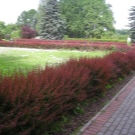

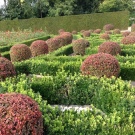


For the features of caring for common barberry, see below.
































































The comment was sent successfully.